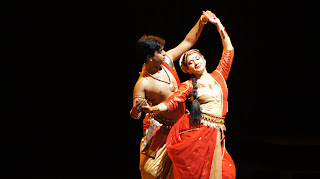The Panchali perspective
 |
| Shivani Wazir Pasrich playing aaj ki naari |
Natya Ballet Centre has been weaving dance dramas around mythological tales. The stories are translated into innovative dance dramas using different genres of classical and contemporary dance. ‘Draupadi’ is a Hindi dance drama woven around the story of ‘Draupadi – the wife of Pandavas’ from the epic of Mahabharata. The dance was a mix of chhau and Odissi. The choreography was by Anirudh Das and Nibedita Mahapatra.
Nibedita is an exponent of Odissi dance. As a choreographer, this is what she had to say about the relevance of the ballet in present times – “Draupadi symbolizes the woman of today. Though the story is thousands of years old, the woman of today has to go through the same turmoil, despite her sacrifices, as it was in the past. Though in contemporary times, women have the strength and potential to surge ahead socially, but they do need the awareness that we have tried to create by relating this story.”
The story
of Draupadi has been visited time and again with different perspectives. She is
an idealistic and inimitable character. She was the daughter of Yagya, she was
the friend of Lord Krishna and named after him, she was the wife of the great Pandavas,
and the cause of the great battle of Mahabharata.
Being born to the Yagya, she grew up to be a fine woman, also called Krishna. In a swayamwar, she is married to the great archer, Arjun. But destiny makes her the wife of all the five Pandava brothers. She readily accepts her fate but is dealt another blow when her husbands lose her to the wicked Kauravas in a game of dice. She is dragged to the court and the cruel Duhshasana tries to disrobe her. It is then that Lord Krishna saves her modesty by making her sari endless. Blind with rage and thoughts of revenge, she vows to bathe her hair with the blood of Duhshasana, her tormentor. Thus, she becomes the cause of the epic battle of Mahabharata.
It was this tale that the choreographer narrated through the dance. The costumes of the dancers were styled aesthetically, especially the body painting of the Kauravas. The performance started with ‘Aaj ki naari’ played by Shivani Wazir Pasrich, being carried on a palki. The woman of today speaks her heart about her struggles with candour. She loves nature and her surroundings and is full of hope like a blossoming flower, but is full of questions for this male-dominated society about her identity. She wants to make a statement about her existence. Shivani played the part convincingly and powerfully.
The narrative
begins with Draupadi entering the stage with the Pandavas. The Pandavas have
found their place in swarg, but Draupadi, being a woman, is left behind. She
laments that though she is the reincarnation of virtues like tyaag and
shraddha, she has not found her place in swarg. The older Draupadi was played by
Nibedita herself. Then she plunges into memories of her life. The birth of
Draupadi from a yagyabhoomi is shown. The younger Draupadi was played by Leepsha
Satpati. She emerges from among dancers dancing as flames. Then there is the
portrayal of the merriments at her birth, her education and training as a
warrior princess.











Comments
Post a Comment